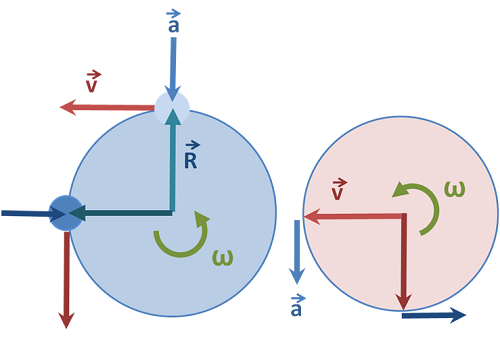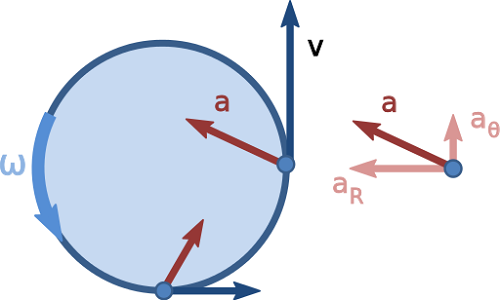Difference Between Uniform and Nonuniform Motion
Movement is a change in the position of an object in relation to other objects. The reference body is the object in comparison with which the movement is observed. There is not an object in nature that is in complete – absolute rest. The path (or trajectory) is the line that the body describes while moving. Paths can be straight or curved, so the movement according to the form of the path is either linear or nonlinear. The linear motion is the most basic motion and is further divided into uniform and nonuniform motion.
What is Uniform Motion?
Тhe simplest form of mechanical motion is the uniform linear movement. The name itself says that it is a uniform movement of a material point in a straight line, i.e. with a constant speed. The speed of linear straight line motion is defined as a change in the position of the body within a given time interval. The basic characteristic of a uniform linear movement is that the displacement is equal to the passed trajectory (distance) . When the body passes equal distances at equal time intervals we say that it moves at constant speed . The relation of the distance and time to an linear uniform movement is always constant. Constant velocity means that the body passes equal movements for equal time intervals, always in the same direction in a straight line. This means that the distance passed in the first second is identical to the distance passed in another second of the movement. In other words the acceleration is equal to zero. In case of rotational (circular) movement, all parts of the object move around the circles lying in parallel planes, whose centres are on the axis of rotation. Equations describing the rotational motion of the body can be derived from the equation of translational motion by putting instead of the path s – angle of rotation φ (rad), velocity c – angular velocity ω (rad/s) and acceleration a – angular acceleration α (rad/s2). In this case, for uniform rotation (ω = const):
What is Nonuniform Motion?
Accelerated motion is part of kinematics in which changes in velocity during motion are studied. The momentary speed is the velocity of the material point at a given moment of time or at a given point of the trajectory. It is equal to the mean speed for a very short time interval Δt. Acceleration is defined as the ratio of the change in velocity and time interval. If the body stands in place or moves at a constant speed it has no acceleration. From this it follows that the acceleration can be represented as an equation in the following manner. The mean speed is the ratio of the total displacement of the body and the size of that time interval. The mean speed should in no way be calculated as an arithmetic mean of the speeds of the individual parts of the movement. With introducing the mean speed, nonuniform movements are identified with a uniform linear motions.
Depending on the acceleration sign, a uniformly variable motion can be: positively accelerated (a> 0) and negatively accelerated (a <0), and in relation to the initial conditions it can be: motion without initial velocity (v0 = 0) and movement with initial velocity (v0 > 0).
Uniformly variable movement is a constant acceleration movement. This means that any change in the speed divided by the time interval will give the same acceleration value. Constant acceleration means an equal speed change at equal intervals. The basic equation for velocity in equally accelerated motion is given by the expression:. In case of variable velocity rotation (positively accelerated α> 0 and negatively accelerated α <0):
Difference Between Uniform and Nonuniform Motion
1. Definition of Uniform and Nonuniform Motion
If one object moves in a straight line and passes equal movements at equal intervals, then it performs a uniform linear movement. Since the speed of movement is determined by the distance in a unit time, the uniform linear motion is a constant speed movement (a=0). In case of uniform movement, the displacements for each second (or other equal intervals) are not identical.
2. Parameters of Uniform and Nonuniform Motion
In case of uniform movement v=const.; a=0; in case of nonuniform movement v≠const; a ≠ 0.
3. Rotational movement of Uniform and Nonuniform Motion
When talking about uniform rotational movement ω=const, and similarly ω≠const in case of nonuniform motion.
Uniform motion vs. Nonuniform motion: Comparison Chart
| Uniform motion | Nonuniform motion |
| Steady (constant) speed of movement | Variable speed |
| Acceleration is zero | Acceleration can be either positive or negative (non-zero) |
| Distances passed in every interval are equal | Distances passed in every interval are not identical |
| The graph is a straight line (distance – time) | The graph is curved |
Summary of Uniform and Nonuniform Motion
A uniform movement is such a movement where the body crosses same paths for the same time intervals. Since the speed of the movement is given by the distance passes in a unit time, the uniform linear motion is a constant-velocity motion. In this case, the actual speed and the average speed of the moving body are same
Nonuniform movement is such a movement where the body crosses different paths for the same time intervals. Movement along a straight line in which the acceleration is constant is called uniformly accelerated linear motion. The average speed is not equal to the average speed of the object. Such examples are free fall, a car with an engine off, a sphere on a steep level and so on.
In case of uniform circular motions the body rotates at a constant speed around a fixed axis or center point. The radial distance is constant. Nonuniform circular motion is characterized with variable angular speed – and there is some radial acceleration.
- Difference Between Thermodynamics and Kinetics - June 24, 2018
- Difference Between Welding and Soldering - June 24, 2018
- Difference Between Additive Colors and Subtractive Colors - June 20, 2018
Search DifferenceBetween.net :
Leave a Response
References :
[0]Singh, S.K. “Kinematics Fundamentals.” Texas: Rice University, Houston, Texas, 2011. Print
[1]McNabb, J.W., Muvdi, B.B. & Al-Khafaji, A.W. “Dynamics for Engineers.” New York: Springer-Verlag, 1997. Print
[2]Waldron, K.J. & Kinzel, G.L. “Kinematics, Dynamics and Design of Machinery.” New York: John Wiley and Sons, 1999. Print
[3]"Image Credit: https://commons.wikimedia.org/wiki/File:Uniform_motion_in_circle.PNG"
[4]"Image Credit: https://commons.wikimedia.org/wiki/File:Nonuniform_circular_motion.svg"


